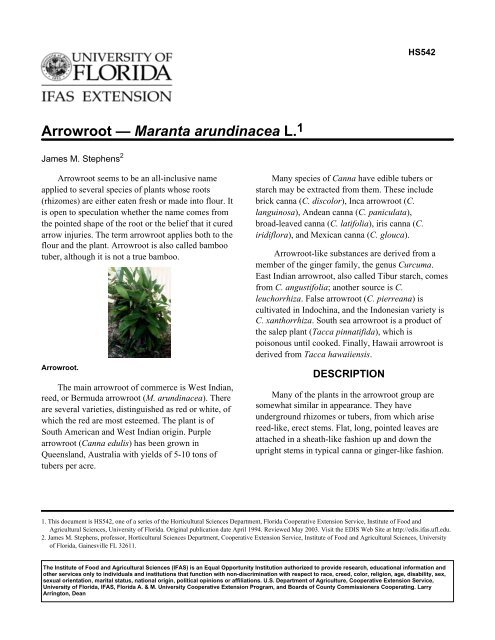Arrowroot — Maranta arundinacea L. 1 - Orange County Extension ...
Arrowroot — Maranta arundinacea L. 1 - Orange County Extension ...
Arrowroot — Maranta arundinacea L. 1 - Orange County Extension ...
You also want an ePaper? Increase the reach of your titles
YUMPU automatically turns print PDFs into web optimized ePapers that Google loves.
<strong>Arrowroot</strong> <strong>—</strong> <strong>Maranta</strong> <strong>arundinacea</strong> L. 1<br />
James M. Stephens 2<br />
<strong>Arrowroot</strong> seems to be an all-inclusive name<br />
applied to several species of plants whose roots<br />
(rhizomes) are either eaten fresh or made into flour. It<br />
is open to speculation whether the name comes from<br />
the pointed shape of the root or the belief that it cured<br />
arrow injuries. The term arrowroot applies both to the<br />
flour and the plant. <strong>Arrowroot</strong> is also called bamboo<br />
tuber, although it is not a true bamboo.<br />
<strong>Arrowroot</strong>.<br />
The main arrowroot of commerce is West Indian,<br />
reed, or Bermuda arrowroot (M. <strong>arundinacea</strong>). There<br />
are several varieties, distinguished as red or white, of<br />
which the red are most esteemed. The plant is of<br />
South American and West Indian origin. Purple<br />
arrowroot (Canna edulis) has been grown in<br />
Queensland, Australia with yields of 5-10 tons of<br />
tubers per acre.<br />
HS542<br />
Many species of Canna have edible tubers or<br />
starch may be extracted from them. These include<br />
brick canna (C. discolor), Inca arrowroot (C.<br />
languinosa), Andean canna (C. paniculata),<br />
broad-leaved canna (C. latifolia), iris canna (C.<br />
iridiflora), and Mexican canna (C. glouca).<br />
<strong>Arrowroot</strong>-like substances are derived from a<br />
member of the ginger family, the genus Curcuma.<br />
East Indian arrowroot, also called Tibur starch, comes<br />
from C. angustifolia; another source is C.<br />
leuchorrhiza. False arrowroot (C. pierreana) is<br />
cultivated in Indochina, and the Indonesian variety is<br />
C. xanthorrhiza. South sea arrowroot is a product of<br />
the salep plant (Tacca pinnatifida), which is<br />
poisonous until cooked. Finally, Hawaii arrowroot is<br />
derived from Tacca hawaiiensis.<br />
DESCRIPTION<br />
Many of the plants in the arrowroot group are<br />
somewhat similar in appearance. They have<br />
underground rhizomes or tubers, from which arise<br />
reed-like, erect stems. Flat, long, pointed leaves are<br />
attached in a sheath-like fashion up and down the<br />
upright stems in typical canna or ginger-like fashion.<br />
1. This document is HS542, one of a series of the Horticultural Sciences Department, Florida Cooperative <strong>Extension</strong> Service, Institute of Food and<br />
Agricultural Sciences, University of Florida. Original publication date April 1994. Reviewed May 2003. Visit the EDIS Web Site at http://edis.ifas.ufl.edu.<br />
2. James M. Stephens, professor, Horticultural Sciences Department, Cooperative <strong>Extension</strong> Service, Institute of Food and Agricultural Sciences, University<br />
of Florida, Gainesville FL 32611.<br />
The Institute of Food and Agricultural Sciences (IFAS) is an Equal Opportunity Institution authorized to provide research, educational information and<br />
other services only to individuals and institutions that function with non-discrimination with respect to race, creed, color, religion, age, disability, sex,<br />
sexual orientation, marital status, national origin, political opinions or affiliations. U.S. Department of Agriculture, Cooperative <strong>Extension</strong> Service,<br />
University of Florida, IFAS, Florida A. & M. University Cooperative <strong>Extension</strong> Program, and Boards of <strong>County</strong> Commissioners Cooperating. Larry<br />
Arrington, Dean
<strong>Arrowroot</strong> <strong>—</strong> <strong>Maranta</strong> <strong>arundinacea</strong> L. 2<br />
CULTURE<br />
The starchy rhizomes of true arrowroot, M.<br />
<strong>arundinacea</strong>, are long, pointed, and enclosed with<br />
bracts. It is propagated by tubers or suckers planted 6<br />
inches deep and spaced 15 inches apart in furrows 30<br />
inches apart. <strong>Arrowroot</strong> should be planted at a time<br />
when it will have 10-11 months of hot moist weather<br />
to mature. Under these conditions, yields of 4-6 tons<br />
per acre can be expected. Tubers are reported to<br />
contain 12% dry arrowroot (flour) and 1.7% protein.<br />
POTENTIAL FOR PRODUCTION<br />
Although arrowroot is grown to a very limited<br />
extent in South Florida, very little information has<br />
been gathered concerning this crop's growth<br />
responses and possibilities here. At Gainesville, top<br />
growth was fair, but root growth was not evaluated.

















